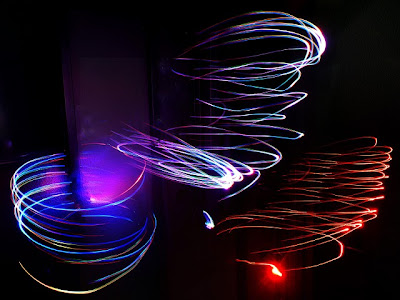Trent's BCT Journal, Entry One
The Chronicles of
Well, here goes... My first [belated] post for my BCT blog.
This post covers our most recent project, a robot that paints... With light!
This project was the real starting point for us in terms of significance and application of skill. Instead of simply spending a day or two tinkering with different tools and software, we were given a little over a week to produce a robot that 'draws'. This, of course, draws from the previous exercises with robotics and visualising data. These two disciplines fuse in much the same way as our final robot fused machinery, art and science.
The project itself, once again, involved use of Lego's NXT kit - an entry-level robotics set designed by Lego for aspiring programmers and students. Naturally, this encouraged a few jokes about playing with Lego at university, but these soon died down as we all realised what sort of predicament we were in. To start, we decided to spend a full day coming up with ideas and then research that night, instead of jumping headfirst into an unstructured project.
Pictured: Structure
After many ideas, drafts and prototypes (up to and including designs with lasers, fire and explosive compounds) we came up with a machine that 'painted' with light. Now, at the time we felt rather original, but as time progressed it became increasingly clear that we weren't the only ones doing light painting. Of course, this could have been avoided if any of us had given the brief a thorough read (cue facepalm) - right smack in the middle, it suggested light painting as a viable output. Nonetheless, after we came back with conclusions drawn from research done that night, it seemed like a feasible and interesting idea so we kept at it.
The first problem we faced with the actual robot involved the way it was going to move. Would it paint on a grid? Or maybe abstract? Where, on the floor? The wall? The ceiling? This was something we needed to sort out early in order to progress to another stage of construction. Meanwhile, a few of us were toying around with different modes of input. Some of the ideas involved music, images and even touch. Eventually, we decided on using coloured balls with the NXT's colour detector in a sequence as both instructions and modifiers. As this decision was made fairly early, it gave Jared enough time to work on the ball holding mechanism, which ended up using the weight of one ball to push another aside to be read by the sensor. This idea eventually morphed into what Ben called 'Colour Without Colour'. In short, the purpose was to take one form (colour) and translate it into a completely different one (movement), while also incorporating time. Interestingly, this was also described as '4D art' in that it uses the dimension of time in addition to the other three spatial dimensions we are all familiar with.
If you look closely, it almost looks like we're making progress!
With the input sorted, the issue was then focused back onto output. By that time we had decided to pursue a more abstract approach to the light painting, in that it would not form any recognisable image, but rather a new one - the robot's interpretation of its sensory input via the colour sensor. This was in part due to mechanical limitations, as we only had three motors and one NXT brick, but also because it looked a little more like a cool idea we'd had around the same time - wavelengths. The idea was to fuse science (physics, in this case) and art and depict the wavelength of different colours in an abstract manner. Of course, the actual light painter moved in a circular pattern as well as up and down, so it was more a spiral than a wave. Fortunately, when viewed from the side, this movement closely resembled a sine wave.
At this point, most of the construction had been completed and it was time to test our robot, now named 'Frank'. Unfortunately, a good portion of testing took place in a small baby changing room, as it was the only place that was both dark enough and didn't have anyone in it. That said, we had a good deal of success the first time around - the only hitches were the colour sensor missing the ball occasionally, and the part with the LED on it coming up too far and breaking the whole setup. Thus the nickname 'Frank the Suicidal Robot' was born, to aptly describe his tendency for self-destruction. Thankfully nothing required any significant rebuilding, only some minor adjustments to the sensor and the code.
Turns out, things like this are quite prone to breaking. Who knew?
By this time we were nearing the deadline, and after some extensive testing, we found a good place to demonstrate Frank's amazing abilities. Unfortunately, this became a problem as the presentation had to be done in the studio, so we were effectively stripped of our presentation. Nonetheless, what we did manage to pull together went without any significant hitch.
Looking back, this was both a stimulating and entertaining project that had a lot to offer to all participants. Not only did it give us a good introduction to robotics, it was also a great opportunity to explore ideas more fully and work more effectively as a team. Also we built a freaking robot, which is totally awesome.
The Final Product
Definitely looking forward to the next project!
(read: watch this space for impending disaster)







No comments:
Post a Comment